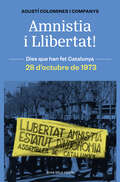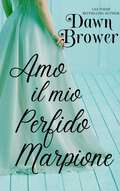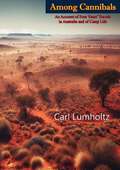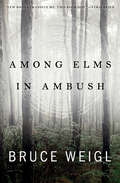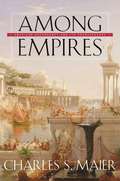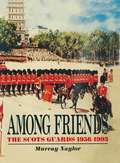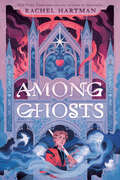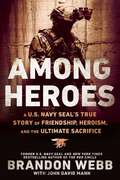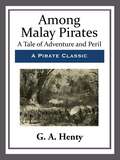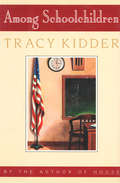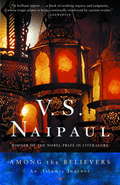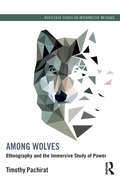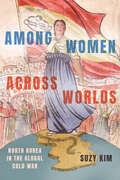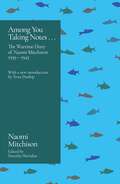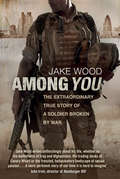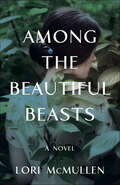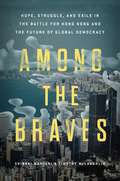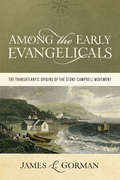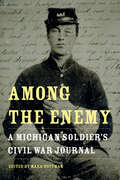- Table View
- List View
Amnistia i llibertat!: Els 113 de l'Assemblea de Catalunya i el final del franquisme. 28 d'octubre de 1973
by Agustí Colomines i CompanysEl 28 d'octubre de 1973, la policia va detenir cent tretze persones a l'església de Santa Maria Mitjancera de Barcelona. Totes elles participaven en una reunió clandestina de l'Assemblea de Catalunya, l'organisme unitari de l'oposició catalana constituït el 7 de novembre de 1971. A partir d'aquest fet, Agustí Colomines i Companys ens parla del canvi cultural i polític de finals dels anys seixanta i principis dels setanta del segle XX, que va propiciar la confluència unitària de diversos grups enfrontats des de la fi de la Guerra Civil. Al crit d'Amnistia i llibertat!, els treballadors de les fàbriques, els estudiants, els veïns dels barris i dels pobles de tot Catalunya van ser els protagonistes de les mobilitzacions populars que culminaren en les manifestacions de l'1 i del 8 de febrer de 1976, i en el primer Onze de Setembre legal a Sant Boi de Llobregat aquell mateix any.L'observació de l'evolució dels partits polítics i de la societat catalana dona vida a les pàgines d'aquest llibre. Amb una prosa amena, l'autor aporta documentació inèdita, en especial dels arxius dels EUA, sobre la visió que les autoritats estatunidenques tenien de Catalunya i de l'oposició catalana a la dictadura. Així mateix, incorpora les aportacions acadèmiques més recents per reconstruir els anys previs al retorn del president Tarradellas i la restauració de la Generalitat de Catalunya
Amo il mio perfido marpione (Gentiluomini Scandalosi #1)
by Dawn BrowerQuando Lady Francesca Kendall si trova in una situazione delicata, deve prendere una decisione, e nulla le sembra giusto. Invece di discernere cosa dovrebbe fare da sola, fa una visita a Matthew Grant, il duca di Lindsey, e scarica i suoi problemi su di lui, sperando che faccia le cose da gentiluomo e si assuma la responsabilità del dilemma che ha contribuito a creare.
Amon's Secret: A Family Story of the First Christians
by Arnold YtreeideBest-selling author of family-tailored Lent and Advent books is back with a new adventureAdding to his widely popular Advent and Lent series, well-known author Arnold Ytreeide revisits the Jerusalem of Jesus in this captivating follow-up to Amon's Adventure. This time, Ytreeide takes families into the life of one of the founders of the church.Thirteen-year-old Amon has just watched Jesus ascend into heaven. What will Christ's followers do now? In the midst of Amon's confusion, the apostle Peter hands him an assignment: invent a way for the new Christian church to communicate and meet in secret. It must not be noticed by the penetrating eyes of Jesus' enemies who are still looking for anyone who dared call him the Messiah.Amon's task quickly turns dangerous. The Sanhedrin, led by Saul, begins hunting down believers in "The Way," even stoning some to death. Now Amon must walk a treacherous line between finishing the job he was given and working safely around those who would kill him if they knew his secret. Can he dodge cranky Romans and angry Pharisees and find a way for the new church to survive?With short, action-filled chapters, reflections for family devotions, and a foundation of archaeological evidence, Amon's Secret is a fun and powerful way to connect to the church's beginnings.
Among Cannibals: An Account Of Four Years' Travels In Australia And Of Camp Life With The Aborigines Of Queensland
by Carl LumholtzCarl Lumholtz’s "Among Cannibals: An Account of Four Years' Travels in Australia and of Camp Life" is a riveting and detailed chronicle of the author’s extraordinary explorations in the remote regions of Australia during the late 19th century. This classic work offers a captivating insight into the diverse landscapes, cultures, and experiences encountered by Lumholtz during his extensive travels.Lumholtz, a renowned Norwegian explorer and ethnographer, embarked on his journey with the goal of studying the indigenous peoples of Australia, particularly those living in the most isolated and unexplored areas. His narrative vividly describes the challenges and triumphs of living in the Australian wilderness, from the dense rainforests of Queensland to the arid outback.Central to "Among Cannibals" is Lumholtz’s deep engagement with the Aboriginal communities he encounters. His empathetic and respectful approach to understanding their way of life, customs, and beliefs provides readers with a nuanced and humanizing portrayal of these cultures.Lumholtz’s narrative is not only a valuable ethnographic record but also an adventurous travelogue that captures the reader’s imagination. His encounters with wildlife, the natural beauty of the Australian landscape, and the everyday challenges of camp life are described with vivid detail and a keen sense of wonder."Among Cannibals" is a seminal work in the fields of anthropology and exploration, offering timeless insights into the lives of Australia’s indigenous peoples and the spirit of adventure that drove explorers like Lumholtz. This book remains an essential read for anyone interested in anthropology, Australian history, and the enduring allure of exploration.
Among Elms, in Ambush
by Bruce WeiglThis powerful new work by Bruce Weigl follows the celebrated poet and Vietnam War veteran as he explores combat, survival, and PTSD in brief prose vignettes. In compact, transcendent, and poetic prose, Bruce Weigl chronicles somber observations on the present day alongside painful memories of the war. Reflections on school shootings and the lightning-fast spread of news in the 21st century are set alongside elegies for forgotten soldiers and the lifelong struggle of waiting for the trauma of war to fade. Haunting and nuanced, Among Elms, in Ambush carries readers through meditations and medications, past the shapes of figures in the dark rice fields of Viet Nam and the milkweed pods in the frost-covered fields of Ohio, toward a hard-won determination to survive.
Among Empires: American Ascendancy and Its Predecessors
by Charles S. MaierContemporary America, with its unparalleled armaments and ambition, seems to many commentators a new empire. Others angrily reject the designation. What stakes would being an empire have for our identity at home and our role abroad? A preeminent American historian addresses these issues in light of the history of empires since antiquity. This elegantly written book examines the structure and impact of these mega-states and asks whether the United States shares their traits and behavior. Eschewing the standard focus on current U.S. foreign policy and the recent spate of pro- and anti-empire polemics, Charles S. Maier uses comparative history to test the relevance of a concept often invoked but not always understood. Marshaling a remarkable array of evidence--from Roman, Ottoman, Moghul, Spanish, Russian, Chinese, and British experience--Maier outlines the essentials of empire throughout history. He then explores the exercise of U.S. power in the nineteenth and twentieth centuries, carefully analyzing its economic and strategic sources and the nation's relationship to predecessors and rivals. To inquire about empire is to ask what the United States has become as a result of its wealth, inventiveness, and ambitions. It is to confront lofty national aspirations with the realities of the violence that often attends imperial politics and thus to question both the costs and the opportunities of the current U.S. global ascendancy. With learning, dispassion, and clarity, Among Empires offers bold comparisons and an original account of American power. It confirms that the issue of empire must be a concern of every citizen.
Among Friends: The Scots Guards, 1956–1993
by Murray NaylorThis book provides a complete insight into the history of the Scots guards from 1956-1993.
Among Ghosts
by Rachel HartmanSet in the world of New York Times bestseller Seraphina, a boy on the run from a dragon—among other dangers—seeks refuge in a haunted abbey in this wholly original ghost story about what haunts us, and what connects us.A few things to know about the town of St. Muckle&’s: It&’s too out-of-the-way to interest greedy lords, and too damp and muddy for marauding dragons to burn. And anyone, from a humble serf to a runaway nun, may earn their freedom by living for a year and a day within the town walls. Seven years ago, Charl and his mother fled to St. Muckle&’s and made it their safe-haven, building a new life in this so called Peasant&’s Paradise. But when Charl sees something impossible—a ghost—soon the embers of his past are threatening to engulf his world in flame. A tragic accident is quickly followed by murder, a deadly plague, and a mercenary dragon. Charl manages to escape to an abandoned abbey outside of town, but finds no safety within those ruined walls. A treacherous nun, a chorus of murdered girls, and the fearsome Battle Bishop await, ready to ensnare him in a complex web of history, magic and fate. For some things should never be forgotten, however much they haunt us, and Charl will need all his wisdom and resiliency if he is to fight for the world he knows…and the people he calls home.Discover more critically-acclaimed fantasy from Rachel Hartman!SeraphinaShadow ScaleTess of the Road
Among Ghosts
by Rachel HartmanSet in the world of New York Times bestseller Seraphina, a boy on the run from a dragon — among other dangers — seeks refuge in a haunted abbey in this wholly original YA ghost story about what haunts us, and what connects us.A few things to know about the town of St. Muckle's: It's too out-of-the-way to interest greedy lords, and too damp and muddy for marauding dragons to burn. And anyone, from a humble serf to a runaway nun, may earn their freedom by living for a year and a day within the town walls. Seven years ago, Charl and his mother fled to St. Muckle's and made it their safe-haven, building a new life in this so-called Peasant's Paradise. But when Charl sees something impossible — a ghost — soon the embers of his past are threatening to engulf his world in flame. A tragic accident is quickly followed by murder, a deadly plague, and a mercenary dragon. Charl manages to escape to an abandoned abbey outside of town, but finds no safety within those ruined walls. A treacherous nun, a chorus of murdered girls, and the fearsome Battle Bishop await, ready to ensnare him in a complex web of history, magic, and fate. For some things should never be forgotten, however much they haunt us, and Charl will need all his wisdom and resiliency if he is to fight for the world he knows . . . and the people he calls home.Discover more critically acclaimed fantasy from Rachel Hartman!SeraphinaShadow ScaleTess of the RoadIn the Serpent's Wake
Among Heroes
by John David Mann Brandon WebbNow from Brandon Webb, Navy SEAL sniper and New York Times bestselling author, comes his personal account of the eight friends and fellow SEALs who made the ultimate sacrifice. "Knowing these great men--who they were, how they lived, and what they stood for--has changed my life. We can't let them be forgotten. So read about these amazing men, share their stories, and learn from them as I have. We've mourned their deaths. Let's celebrate their lives."--Brandon WebbAs a Navy SEAL, Brandon Webb rose to the top of the world's most elite sniper corps, experiencing years of punishing training and combat missions from the Persian Gulf to Afghanistan. Among the best of the best, he led the SEALs' clandestine sniper training program as course manager, instructing a new generation of the world's top snipers. Along the way, Webb served beside, trained, and supported men he came to know not just as fellow warriors, but as friends and, eventually, as heroes. Among Heroes gives his personal account of these eight extraordinary SEALs, who gave all for their comrades--and their country.Here are the true stories behind the remarkable valor and abiding humanity of those "sheepdogs" (as they call themselves) who protect us from the wolves of the world. Of Matt "Axe" Axelson, who perished on the Lone Survivor mission in Afghanistan. Of Chris Campbell, Heath Robinson, and JT Tumilson, who were among the thirty-eight casualties of Extortion 17, the Chinook helicopter shot down in August 2011. Of Glen Doherty, Webb's best friend for more than a decade, killed while helping secure the successful rescue and extraction of American CIA and State Department diplomats in Benghazi, Libya, on September 11, 2012; and other close friends, classmates, and fellow warriors.In Among Heroes, Webb offers eight intensely personal profiles of uncommon courage--who these men were, what they stood for, and how they came to make the ultimate sacrifice. These are men who left behind powerfully instructive examples of what it means to be alive--and what it truly means to be a hero.INCLUDES PHOTOS
Among Malay Pirates
by G. A. HentyAmong Malay Pirates is a story of courage and danger. Join our heroes as they pit themselves against blood thirsty pirates and epic sea storms. A magnificent swashbuckling story of a grander more adventurous time.
Among Schoolchildren
by Tracy KidderThe Pulitzer Prize–winning author&’s classic, &“brilliantly illuminated&” account of education in America (TheNew York Times Book Review). Mrs. Zajac is feisty, funny, and tough. She likes to call herself an &“old-lady teacher.&” (She is thirty-four.) Around Kelly School, she is infamous for her discipline: &“She is mean, bro,&” says one of her students. But children love her, and so will the reader of this extraordinarily moving book by the Pulitzer Prize–winning author of House and The Soul of a New Machine. Tracy Kidder spent nine months in Mrs. Zajac&’s fifth-grade classroom in a depressed area of Holyoke, Massachusetts. Living among the twenty schoolchildren and their indomitable teacher, he shared their joys, catastrophes, and small but essential triumphs. His resulting New York Times bestseller is a revelatory and remarkably poignant account of an inner-city school that &“erupts with passionate life,&” and a close-up examination of what is wrong—and right—with education in America (USA Today). &“More than a book about needy children and a valiant teacher; it is full of the author&’s genuine love, delight and celebration of the human condition. He has never used his talent so well.&” —The New York Times
Among The Believers
by V. S. NaipaulNaipaul's controversial account of his travels through the Islamic world, hailed by The New Republic as "the most notable work on contemporary Islam to have appeared in a very long time."From the Trade Paperback edition.
Among Wolves: Ethnography and the Immersive Study of Power (Routledge Series on Interpretive Methods)
by Timothy PachiratSummoned by an anonymous Prosecutor, ten contemporary ethnographers gather in an aging barn to hold a trial of Alice Goffman’s controversial ethnography, On the Run. But before the trial can get underway, a one-eyed wolfdog arrives with a mysterious liquid potion capable of rendering the ethnographers invisible in their fieldsites. Presented as a play that unfolds in seven acts, the ensuing drama provides readers with both a practical guide for how to conduct immersive participant-observation research and a sophisticated theoretical engagement with the relationship between ethnography as a research method and the operation of power. By interpolating "how-to" aspects of ethnographic research with deeper questions about ethnography’s relationship to power, this book presents a compelling introduction for those new to ethnography and rich theoretical insights for more seasoned ethnographic practitioners from across the social sciences. Just as ethnography as a research method depends crucially on serendipity, surprise, and an openness to ambiguity, the book’s dramatic and dialogic format encourages novices and experts alike to approach the study of power in ways that resist linear programs and dogmatic prescriptions. The result is a playful yet provocative invitation to rekindle those foundational senses of wonder and generative uncertainty that are all too often excluded from conversations about the methodologies and methods we bring to the study of the social world.
Among Women across Worlds: North Korea in the Global Cold War
by Suzy KimIn Among Women across Worlds, Suzy Kim explores the transnational connections between North Korean women and the global women's movement. Asian women, especially communists, are often depicted as victims of a patriarchal state. Kim challenges this view through extensive archival research, revealing that North Korean women asserted themselves from the late 1940s to 1975, before the Korean War began and up to the UN's International Women's Year.Kim centers on North Korea and the "East" to present a new genealogy of the global women's movement. Women of the Korean Democratic Women's Union (KDWU), part of the global left women's movement led by the Women's International Democratic Federation (WIDF), argued that family and domestic issues should be central to both national and international debates. They highlighted the connections between race, nationality, sex, and class in systems of exploitation. Their intersectional program proclaimed "no peace without justice," "the personal is the political," and "women's rights are human rights," long before Western activists adopted these ideas. Among Women across Worlds uncovers movements and ideas foundational to today's era.
Among Women: From the Homosocial to the Homoerotic in the Ancient World
by Lisa Auanger Nancy Sorkin RabinowitzWomen's and men's worlds were largely separate in ancient Mediterranean societies, and, in consequence, many women's deepest personal relationships were with other women. Yet relatively little scholarly or popular attention has focused on women's relationships in antiquity, in contrast to recent interest in the relationships between men in ancient Greece and Rome. The essays in this book seek to close this gap by exploring a wide variety of textual and archaeological evidence for women's homosocial and homoerotic relationships from prehistoric Greece to fifth-century CE Egypt.<P> Drawing on developments in feminist theory, gay and lesbian studies, and queer theory, as well as traditional textual and art historical methods, the contributors to this volume examine representations of women's lives with other women, their friendships, and sexual subjectivity. They present new interpretations of the evidence offered by the literary works of Sappho, Ovid, and Lucian; Bronze Age frescoes and Greek vase painting, funerary reliefs, and other artistic representations; and Egyptian legal documents.
Among You Taking Notes...
by Naomi Mitchison'As in a good novel, the people, their feelings and reactions are instantly recognisable and as fresh and immediate today as they were then' GUARDIAN'She writes vividly and movingly' DAILY TELEGRAPH26th September 1939. I am beginning to wonder whether the point of a place like this may be that it will keep alive certain ideas of freedom which might easily be destroyed in the course of this totalitarian war...Born in Edinburgh, Naomi Mitchison spent most of the Second World War in the fishing village of Carradale on Kintyre, her home until her death aged 101. Her life was crowded with incident, and her attitudes to events predictably forceful, original and honest.Throughout the war she kept a diary at the request of the research organisation Mass Observation, in which she recorded both the momentous events of the time, and also how one (albeit extraordinary) family and their friends lived, what they hoped for and what actually happened. Her diaries developed far beyond the confines of a social document.Written with the passion of a poet combined with the intellectual curiosity of a radial thinker, they provide a unique and valuable document of the period.
Among You Taking Notes...
by Naomi Mitchison'As in a good novel, the people, their feelings and reactions are instantly recognisable and as fresh and immediate today as they were then' GUARDIAN'She writes vividly and movingly' DAILY TELEGRAPH26th September 1939. I am beginning to wonder whether the point of a place like this may be that it will keep alive certain ideas of freedom which might easily be destroyed in the course of this totalitarian war...Born in Edinburgh, Naomi Mitchison spent most of the Second World War in the fishing village of Carradale on Kintyre, her home until her death aged 101. Her life was crowded with incident, and her attitudes to events predictably forceful, original and honest.Throughout the war she kept a diary at the request of the research organisation Mass Observation, in which she recorded both the momentous events of the time, and also how one (albeit extraordinary) family and their friends lived, what they hoped for and what actually happened. Her diaries developed far beyond the confines of a social document.Written with the passion of a poet combined with the intellectual curiosity of a radial thinker, they provide a unique and valuable document of the period.
Among You Taking Notes…
by Naomi Mitchison26th September 1939. I am beginning to wonder whether the point of a place like this may be that it will keep alive certain ideas of freedom which might easily be destroyed in the course of this totalitarian war…. <p><p>Born in Edinburgh, Naomi Mitchison spent most of the Second World War in the fishing village of Carradale on Kintyre, her home until her death aged 101. Her life was crowded with incident, and her attitudes to events predictably forceful, original and honest. <p><p>Throughout the war she kept a diary at the request of the research organisation Mass Observation, in which she recorded both the momentous events of the time, and also how one (albeit extraordinary) family and their friends lived, what they hoped for and what actually happened. Her diaries developed far beyond the confines of a social document. <p><p>Written with the passion of a poet combined with the intellectual curiosity of a radial thinker, they provide a unique and valuable document of the period.
Among You: The Extraordinary True Story of a Soldier Broken by War
by Jake WoodAmong You is the gripping real-life story of a soldier serving on the front line in Iraq and Afghanistan, and an unforgettable, unflinching account of the effects of post-traumatic stress disorder.Jake Wood lives parallel lives: encased in the glass tower of an international investment bank by day, he is also a dedicated TA soldier who serves on the front line during the invasion of Iraq, later returning to the war zone to conduct surveillance on insurgents. Disillusioned with the dullness and amorality of the banking world, he escapes back to the army for a third tour of duty. But in Afghanistan he discovers the savage, dehumanising effects that war has on both the body and the mind. Diagnosed with chronic PTSD on his return, he must now fight the last enemy – himself – in order to exorcise the ghosts of his past.Brutally honest and beautifully written, Among You brings home the harsh reality of front-line combat in Iraq and Afghanistan, and the courage of the troops who risk their lives for their country, as well as revealing the devastating after-effects of service.
Among the Beautiful Beasts: A Novel
by Lori McMullenSet in the early 1900s, Among the Beautiful Beasts is the untold story of the early life of Marjory Stoneman Douglas, known in her later years as a tireless activist for the Florida Everglades. After a childhood spent in New England estranged from her father and bewildered by her mother, who fades into madness, Marjory marries a swindler thirty years her senior. The marriage nearly destroys her, but Marjory finds the courage to move to Miami, where she is reunited with her father and begins a new life as a journalist in that bustling, booming frontier town. Buoyed by a growing sense of independence and an affair with a rival journalist, Marjory embraces a life lived at the intersection of the untamed Everglades and the rapacious urban development that threatens it. When the demands of a man once again begin to swallow Marjory’s own desires and dreams, she sees herself in the vulnerable, inimitable Everglades and is forced to decide whether to commit to a life of subjugation or leap into the wild unknown. Told in chapters that alternate between an urgent midnight chase through the wetlands and extensive narrative flashbacks, Among the Beautiful Beasts is at once suspenseful and deeply reflective.
Among the Believers: An Islamic Journey
by V. S. NaipaulThe Nobel Prize-winning author gives us – on the basis of his own intensive seventeen month journey across the Asian continent – an unprecedented revelation of the Islamic world. • &“A brilliant report…. A book of scathing inquiry and judgment, whose tragic power is being continually reinforced by current events&” (Newsweek).With all the narrative power and intellectual authority that have distinguished his earlier books and won him international acclaim (&“There can hardly be a writer alive who surpasses him&” – Irving Howe, The New York Times Book Review), Naipaul explores the life, the culture, the ferment inside the nations of Islam – in a book that combines the fascinations of the great works of travel literature with the insights of a uniquely sharp, original, and idiosyncratic political mind. He takes us into four countries in the throes of &“Islamization&” – countries that, in their ardor to build new societies based entirely on the fundamental laws of Islam, have violently rejected the &“materialism&” of the technologically advanced nations that have long supported them. He brings us close to the people of Islam – how they live and work, the role of faith in their lives, how they see their place in the modern world.
Among the Braves: Hope, Struggle, and Exile in the Battle for Hong Kong and the Future of Global Democracy
by Shibani Mahtani Timothy McLaughlinThrough the eyes of two frontline journalists comes a gripping narrative history of the Hong Kong pro-democracy movement centered around a cast of four core activists, culminating in the 2019 mass protests and Beijing's brutal crackdown. Hong Kong was an experiment in governance. Handed back to China in 1997 after 156 years of British rule, it was meant to be a carve-out between hostile systems: a bridge between communism and capitalism, authoritarianism and liberal democracy. &“One country, two systems&” kept its media free, its courts independent and its protests boisterous, designed also to convince Taiwan of a peaceful solution to Beijing&’s desire for reunification. Yet this formulation excluded Hong Kong&’s own people, their future negotiated by political titans in faraway capitals. In 2019, an ill-conceived law spear-headed by a sycophantic leader pushed millions to take to the streets in one of the most enduring protest movements the world has ever seen. Xi Jinping responded with a draconian national security law that sought not only to end the demonstrations but quash the &“problem&” of Hong Kongers&’ identity and desire for freedom. Reverend Chu, who believed Hong Kong had to carry the spirit of students at Tiananmen Square, saw his silver-haired comrades who birthed the city&’s modern pro-democracy movement handcuffed and taken from their homes. Tommy, an art student radicalized into throwing Molotov cocktails, watched &“braves&” like him brutalized by police before his own arrest prompted him to flee. Finn epitomized the decentralized nature of the movement and its internet-fueled victories, but online anonymity couldn&’t stop his life from unravelling. Gwyneth could predict her eventual fate when she chose to give up her career as a journalist to stand for election as an opposition candidate, and did it anyway. In Among the Braves, Shibani Mahtani and Timothy McLaughlin tell the story of Hong Kong&’s past, and what the sacrifices of its people mean for global democracy&’s shaky foundation.
Among the Early Evangelicals: The Transatlantic Origins of the Stone-Campbell Movement
by James L. GormanThough many of its early leaders were immigrants, most histories of the Stone-Campbell Movement have focused on the unique, American-only message of the Movement. Typically, the story tells the efforts of Christians seeking to restore New Testament Christianity or to promote unity and cooperation among believers.Among the Early Evangelicals charts a new path showing convincingly that the earliest leaders of this Movement cannot be understood apart from a robust evangelical and missionary culture that traces its roots back to the eighteenth century. Leaders, including such luminaries as Thomas and Alexander Campbell, borrowed freely from the outlook, strategies, and methodologies of this transatlantic culture. More than simple Christians with a unique message shaped by frontier democratization, the adherents in the Stone-Campbell Movement were active participants in a broadly networked, uniquely evangelical enterprise.
Among the Enemy: A Michigan Soldier’s Civil War Journal
by Mark Hoffman William Horton KimballThough many Union soldiers wrote about their experiences in the American Civil War, few had the vantage point of William Horton Kimball, a member of the First Michigan Engineers and Mechanics. As a military engineer, Kimball spent most of his time behind the major lines of conflict and often worked among civilians who sympathized with the enemy. In Among the Enemy: A Michigan Soldier's Civil War Journal, author Mark Hoffman presents Kimball's journal as a unique window into wartime experience. Kimball was a prolific writer, and his journal is full of detailed accounts of expeditions into a hostile countryside, the bitter war against guerillas, and of the civilians caught in the middle of a traditional war waged with nontraditional means. He comments freely and openly on the strengths and weaknesses of his officers and comrades caught up in the same war. At the same time, Kimball provides moving accounts of when the Engineers were thrown into the line of battle at Perryville and Lavergne and proved themselves as soldiers capable of traditional combat. Through Kimball's account, readers can chart the important evolution of Union war policy regarding occupied populations, as well as how the American views of warfare broke down when combat moved from battlefield to countryside and soldiers in the rear became important targets for enemy action. Civil War historian Mark Hoffman introduces Kimball's writings and provides some background on Kimball's life as a soldier. He accompanies the journal entries with illustrations and maps. Kimball's account reminds readers that there was a time when Americans who honored the same founders and national holidays were seeking to kill each other in a bitter war behind the lines of traditional armies. Readers interested in military history and the Civil War will enjoy the inside perspective of Among the Enemy.
